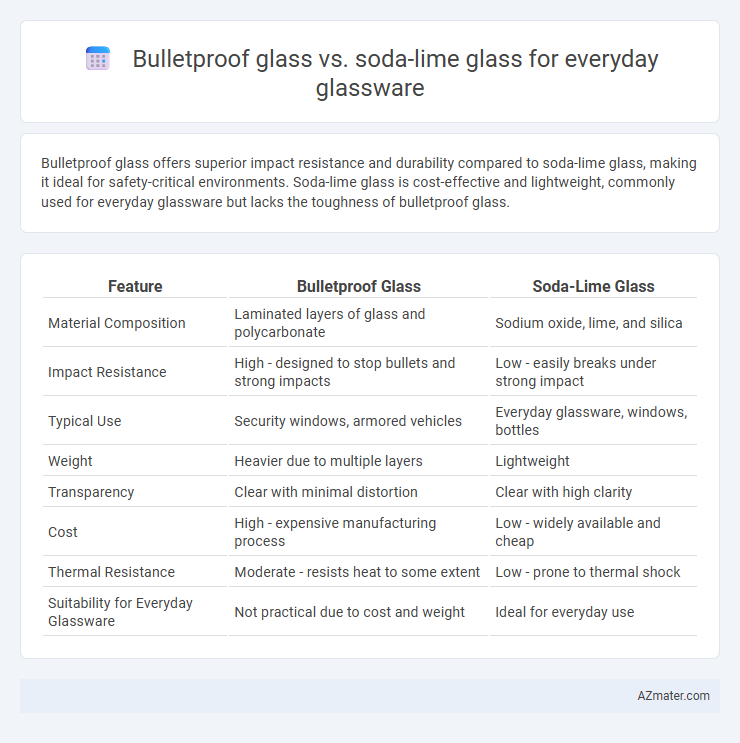Bulletproof glass offers superior impact resistance and durability compared to soda-lime glass, making it ideal for safety-critical environments. Soda-lime glass is cost-effective and lightweight, commonly used for everyday glassware but lacks the toughness of bulletproof glass.
Table of Comparison
| Feature | Bulletproof Glass | Soda-Lime Glass |
|---|---|---|
| Material Composition | Laminated layers of glass and polycarbonate | Sodium oxide, lime, and silica |
| Impact Resistance | High - designed to stop bullets and strong impacts | Low - easily breaks under strong impact |
| Typical Use | Security windows, armored vehicles | Everyday glassware, windows, bottles |
| Weight | Heavier due to multiple layers | Lightweight |
| Transparency | Clear with minimal distortion | Clear with high clarity |
| Cost | High - expensive manufacturing process | Low - widely available and cheap |
| Thermal Resistance | Moderate - resists heat to some extent | Low - prone to thermal shock |
| Suitability for Everyday Glassware | Not practical due to cost and weight | Ideal for everyday use |
Introduction to Everyday Glassware Materials
Bulletproof glass and soda-lime glass differ significantly in composition and durability, with soda-lime glass primarily used for everyday glassware due to its affordability and ease of manufacture. Soda-lime glass consists mainly of silica, soda, and lime, providing adequate strength and clarity for common household items like drinking glasses and windows. Bulletproof glass, a laminated composite made of polycarbonate layers and tempered glass, offers superior impact resistance but is impractical and cost-prohibitive for routine glassware applications.
What is Bulletproof Glass?
Bulletproof glass is a type of laminated glass designed to resist penetration by firearms and heavy impacts, typically composed of multiple layers of glass and polycarbonate. Unlike soda-lime glass, which is commonly used in everyday glassware for its affordability and ease of production, bulletproof glass offers superior strength, durability, and impact resistance. This enhanced protection makes bulletproof glass unsuitable for typical household glassware but indispensable in security applications such as bank teller windows and armored vehicles.
Understanding Soda-Lime Glass
Soda-lime glass, the most common type used in everyday glassware, is composed primarily of silica, sodium oxide, and calcium oxide, offering cost-effectiveness and ease of manufacturing. It provides adequate clarity and durability for regular use but lacks the impact resistance and shatterproof properties found in bulletproof glass. Understanding the chemical composition and physical limitations of soda-lime glass helps consumers make informed choices when selecting glassware for daily use.
Durability Comparison: Bulletproof vs Soda-Lime Glass
Bulletproof glass offers superior durability compared to soda-lime glass due to its multi-layered construction, which resists impacts, scratches, and shattering much more effectively. Soda-lime glass, commonly used in everyday glassware, is more prone to chips, cracks, and breakage under stress, making it less reliable for heavy use or accidental drops. The enhanced toughness of bulletproof glass ensures a longer lifespan and greater safety in environments where durability is critical.
Transparency and Clarity Differences
Bulletproof glass offers enhanced durability but often exhibits lower transparency and clarity compared to soda-lime glass due to its layered construction and thicker composition. Soda-lime glass, commonly used in everyday glassware, provides superior optical clarity with minimal distortion, making it ideal for visual applications requiring high translucency. The clarity differences arise from soda-lime's uniform molecular structure versus bulletproof glass's laminated polymers, which can slightly reduce light transmission and increase haze.
Safety and Impact Resistance
Bulletproof glass offers superior impact resistance compared to soda-lime glass, making it significantly safer for everyday glassware in environments prone to accidental drops or impacts. Soda-lime glass, while cost-effective and widely used, is more prone to shattering into sharp shards, increasing the risk of injury. The laminated structure of bulletproof glass absorbs and disperses energy, reducing breakage hazards and enhancing overall safety in glassware applications.
Weight and Handling in Daily Use
Bulletproof glass is significantly heavier than soda-lime glass due to its layered construction, making it less practical for everyday glassware where lightweight handling is preferred. Soda-lime glass offers a more manageable weight and ease of use, ideal for daily tasks such as drinking, serving, and cleaning. The reduced weight of soda-lime glass enhances comfort and efficiency, whereas bulletproof glass can cause fatigue and inconvenience in routine handling.
Cost Factors and Affordability
Bulletproof glass typically costs significantly more than soda-lime glass due to its complex manufacturing process and enhanced durability, making it less affordable for everyday glassware applications. Soda-lime glass, the most common type used in household items, offers a low-cost solution with adequate strength for daily use, appealing to budget-conscious consumers. Choosing soda-lime glass over bulletproof glass reduces material expenses while still meeting the functional requirements of typical everyday glassware.
Environmental Impact and Recyclability
Bulletproof glass, typically made from laminated layers of glass and polycarbonate, has a significantly higher environmental impact due to its complex manufacturing process and difficulty in recycling. Soda-lime glass, the most common type of everyday glassware, is more environmentally friendly because it can be recycled repeatedly without quality loss, reducing raw material consumption and landfill waste. Preference for soda-lime glass in household items enhances sustainability by supporting circular economy practices and lowering carbon emissions associated with production and disposal.
Which Glass is Best for Everyday Use?
Bulletproof glass offers exceptional durability and impact resistance, making it ideal for environments prone to accidents, but its higher cost and weight limit its practicality for everyday glassware. Soda-lime glass, commonly used in household items, provides sufficient strength, clarity, and affordability for daily use while being lightweight and easy to replace. For typical everyday glassware, soda-lime glass is the best balance of cost-efficiency, usability, and performance.

Infographic: Bulletproof glass vs Soda-lime glass for Everyday glassware
 azmater.com
azmater.com